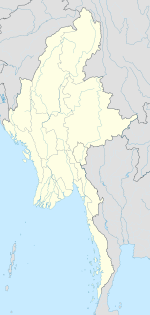
Back معركة جزيرة رامري Arabic رامره دؤیوشو AZB Batalla de l'illa Ramree Catalan Schlacht von Ramree German Batalla de la isla Ramree Spanish نبرد جزیره رامره Persian Bataille de Ramree French Pertempuran Pulau Ramree ID Battaglia dell'Isola Ramree Italian ラムリー島の戦い Japanese
| Battle of Ramree Island | |||||||
|---|---|---|---|---|---|---|---|
| Part of The Burma campaign | |||||||
 British troops in landing craft make their way ashore on Ramree Island, 21 January 1945. | |||||||
| |||||||
| Belligerents | |||||||
|
| |||||||
| Commanders and leaders | |||||||
| Cyril Lomax | Kan'ichi Nagazawa | ||||||
| Units involved | |||||||
| Two brigades, 26th Indian Infantry Division; one squadron, 146 Regt, RAC, elements of 3 Commando Brigade | 2nd Battalion, 121st Regiment, 54th Division | ||||||
| Strength | |||||||
| c. 6,000 | c. 1,000 | ||||||
| Casualties and losses | |||||||
| "Trifling"[1] |
c. 500 killed 20 captured c. 500 evacuated to the mainland | ||||||
Burma (Myanmar) | |||||||
The Battle of Ramree Island (Burmese: ရမ်းဗြဲကျွန်း တိုက်ပွဲ), also known as Operation Matador, took place from 14 January to 22 February 1945, in the Second World War as part of the offensive on the Southern Front in the Burma campaign and was conducted by the XV Indian Corps.
Ramree Island, part of Arakan (now Rakhine State), has an area of 520 sq mi (1,350 km2) and is separated from the mainland by a strait with an average width of about 490 ft (150 m); the island is 70 mi (110 km) south of Akyab (now Sittwe). During the Japanese invasion of Burma in early 1942, the Island had been captured. In January 1945, forces of the Indian XV Corps landed on Ramree and the neighbouring island of Cheduba, to establish airfields for the supply of the mainland campaign.
The battle is known for claims that hundreds of Japanese soldiers were killed by crocodiles in the mangrove swamps of Ramree. Some editions of the Guinness Book of World Records have described this as the highest number of fatalities in an animal attack; zoologists and modern military historians have dismissed these claims.[2]
- ^ Woodburn Kirby 2004, p. 250.
- ^ Russell 1987, p. 216; Kynaston 1998, p. 135.
